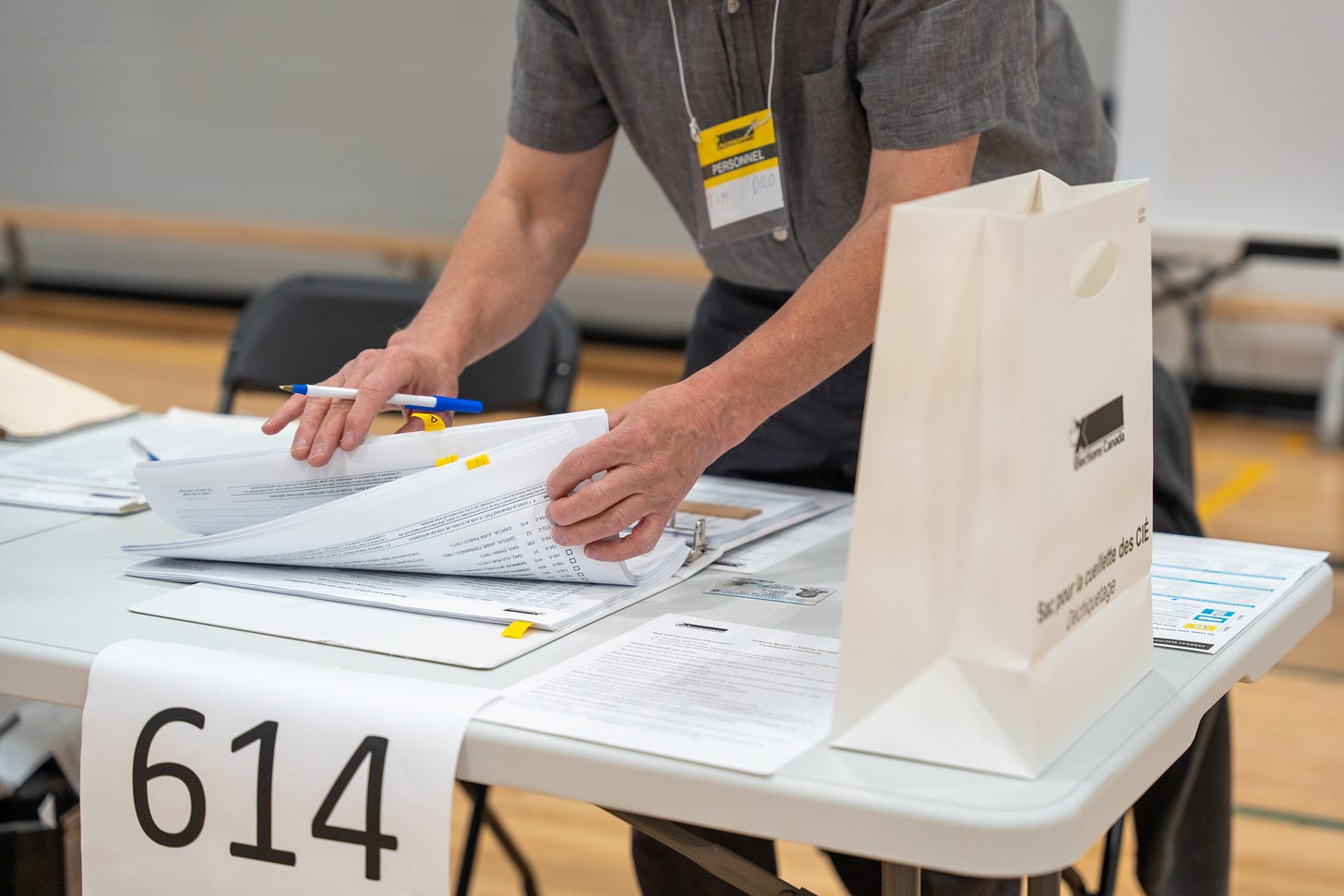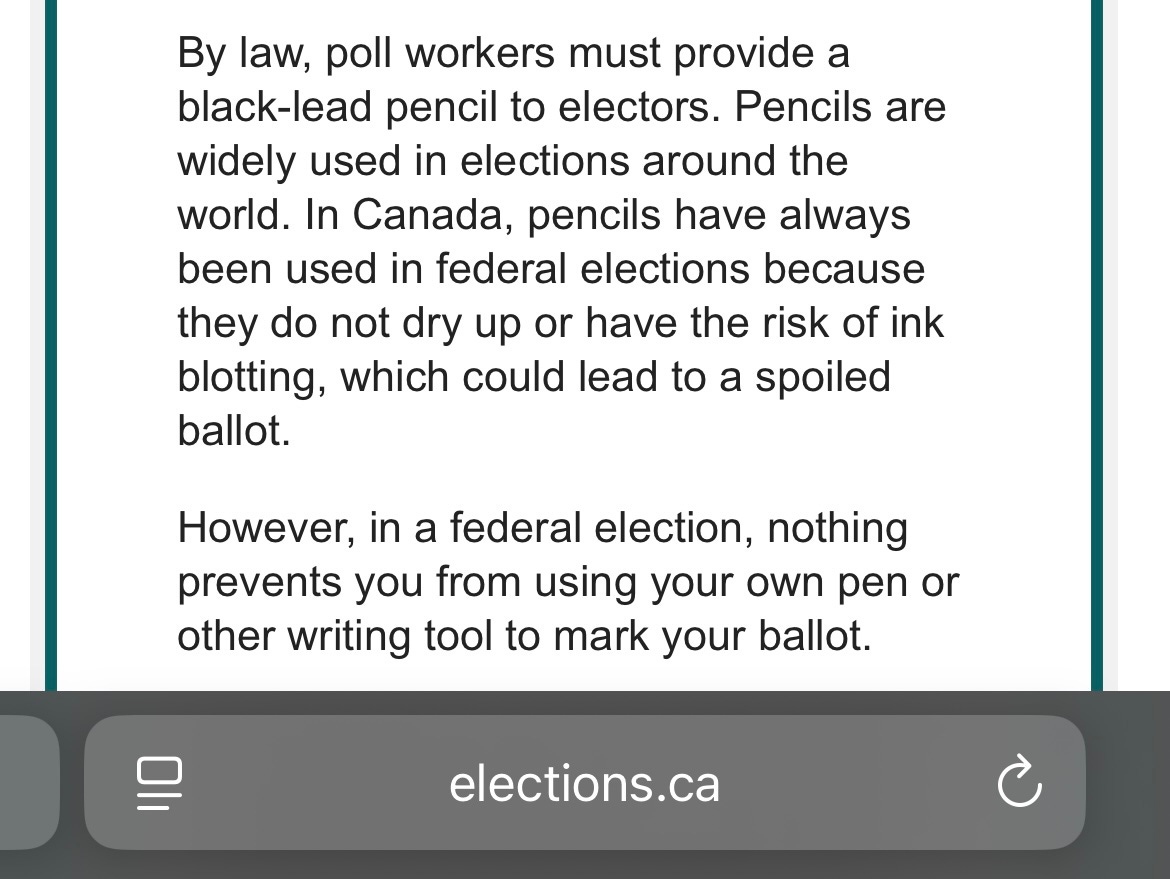Canadian Voters Yearn for (No) Change
Polling day tales from the land of politeness, potlucks, and very sharp pencils
Just because I’m still not quite ready to dive back into down and even dirtier than it looks party politics doesn’t mean I’m against lending (or leasing) my services to the democratic cause. For the second time in two months, I took on the role of poll site supervisor, helping ensure the election process went as smoothly and pleasantly as possible. After all, voting for these candidates is often about as enjoyable as passing kidney stones, so I’ve taken it upon myself to make the whole experience as painless as I can.
Here are some thoughts from the front lines of The Fowlers Corners Lions Club in Orange Corners (a mere 650 meters from my front door, and definitely not in Fowler’s Corners).
Canadian Voters Yearn for (No) Change
In an election partially dominated by Donald Trump’s attacks on our sovereignty and economy, a long-in-the-tooth(ache) Liberal Party, and a national mood for “change,” the time was ripe for the Conservative Party to finally get the keys to the House of Commons. Instead, Canadian voters proved—once again—that they mostly just want their political parties to stay frozen in the amber of their political nostalgia—somewhere between 1961 and the mid-1990s.
Looking at the results of yesterday’s election (a loss of ground by the Liberals, a Leafs-level choke by the Conservatives—yes, the Buds are going to get dusted in the second round—and another election where NDP supporters were badgered into voting Liberal), I couldn't help but notice that these outcomes were reflected not only in the vote totals, but also in some of the many conversations I overheard at my polling location. The general sentiment seemed to echo a national desire for change that, when it came down to it, wasn’t as radical as predicted, and might point instead to a yearning for the Canadian party politics of yore.
With that in mind, let’s take a look at each party’s base—and how those bases actually see the party they’re voting for.
Front Runners
The Liberals (Re-elected)
Quite a few voters would have been OK with the old guy, Trudeau, who—let’s face it—actually did a pretty good (if sometimes wildly tone-deaf) job of steering us through both COVID and the economic fallout. He was just kinda left on the counter too long and went a bit sour.
But they were absolutely ecstatic about the new guy, “Big Daddy” Carney, whose arrival was like getting to open a present on Christmas Eve.
Any way the salami was sliced, most would have voted the same way anyway. Liberals, see, are a committed bunch. They live and die (although, like cockroaches, now seem to be immune to anything) by the centrist, big-promise/shaky-follow-through, woo-the-left-with-sky-is-falling-emergency-voting, “Hey, we’ve been here since 1867” brand that works for them.
A vote for the Liberals is literally a vote for the status quo. Don’t go changing.
The Conservatives (a close 2nd)
The Conservatives have a serious problem—they’ve got three and a half bases, and none of them are compatible. Ever since they merged with the Reform Party in 2003, they’ve been trying to braid oilfield libertarianism, red-Tory communitarianism, and anti-everything populism into one coherent narrative. That’s like trying to knit a sweater out of three raccoons. On meth. During mating season.
You’ve got the Blue Tories—fiscally tight, socially moderate, still believe in the “rule of law,” and probably still wear socks with loafers.
Then there are the Red Tories—a half-base at best, an endangered species of swing voters who fondly remember when “compassionate conservatism” didn’t mean shouting at cashiers.
Next, the Reform/Alliance crowd—Western populists suspicious of government, centrists, Quebec, immigrants, and probably kale.
And finally, the rise of the American-style culture-war right: convoy-fundraising, mask-hating, romance Trudeau fans who think “owning the libs” is a viable economic strategy.
The only reason the Conservatives lost an election where the Liberals were limburger and the national mood was “pleeeeeaaaaassssse fix our personal economies,” is because instead of coming across as a government-in-waiting, they looked like an angry Reddit thread that somehow got a campaign bus.
Poilievre tried to unify them under the banner of “common sense,” but in 2025, when reality itself is in short supply, you don’t get common sense—you get chaos. When Conservative Provincial Premiers are racing each other for distance away from the Federal mothership, you know there are issues.
At this point, CPC, your best bet to win back your base(s) is a divorce—with the kids orphaned off to the People’s Party of Canada.
The Also-rans
The NDP (4th place and a not-surprising loss of Party status)
Simple. More like Tommy, less like Justin.
And really happy with a third-place finish.
Make it so.
The Bloc (3rd Place, but placed lower here due to its regional flavour of poutine and Fèves au Lard)
Plus ça change.
(That’s it. That’s the review.)
Bonus Round
The Green Party of Canada
Any excuse for a potluck.
The PPC
Tinfoil rattles.
Liberty screams in Morse code.
Conspiracy Theory of the Night: The Pencil Plot
In the days leading up to the election, a truly Canadian conspiracy theory started making the rounds on the socials: advanced polling stations were forcing people to vote with pencils—so that “they” (probably the World Economic Forum) could erase your vote and rewrite it in favour of the Liberals.
As a poll site supervisor, I can confirm this is utter moosecrap.
Not only were people allowed to vote with pens, but also with markers, eyeliner, lip gloss, and—if they'd brought it—the blood of Stephen Harper, sourced from an International Democratic Union Shopify store.
There was no graphite mandate.
More importantly, the vote-counting process is more transparent than your uncle’s opinions after a sixer of Molson Ex. Each ballot box is counted by 2–3 people who often just met that day, at separate tables, while myriad site and vote supervisors make the rounds and a few orbiting Info Officers stand eager to put away the tables where the votes are being tabulated
So in my polling station alone, you'd need at least 20 people—a mix of retirees, high school and college students, and random locals—to coordinate a multi-partisan, pencil-based fraud operation.
And here's the kicker: about a third of them were from this rural hood.
So unless you think Sharon from book club is part of a Dominion Voting sleeper cell activated by graphite and gluten-free muffins, it’s time to retire the Pencil Panic.
The only conspiracy here is how hard it is for some folks to accept that Canadians—by and large—don’t want massive change. They want quiet governance, free healthcare, and to be left alone until it’s time to talk about the Leafs.
And yet, I had an easy baker’s dozen ask me about pencils, pens, and other voting accoutrement.
I hate the internet.
After supervising two elections, exactly two months and one day apart, I just want to express—once again—how flipping nice everyone was during the whole thing. From the site vote supervisors to the registration officers to the deputy returning officers to the information officers, everyone was eager to please and exceptionally kind. They absolutely rocked, just like in the provincial election.
As for the voters? No fuss. No muss. Lots of smiles. Lots of laughs. No confrontation. People were even good with the pencil chats.
We had almost 1,000 voters come through, meaning my peeps were processing roughly a voter and a half per minute. It was honking busy. And we were perfectly gruntled the entire time.
Canada, eh?







The Conservatives, as they stand, would more accurately be branded as the Regressive Conservatives, as opposed to their more mainstream forerunner, the Progressive Conservatives. Especially given their position on trans, Indigenous, and disabled rights.